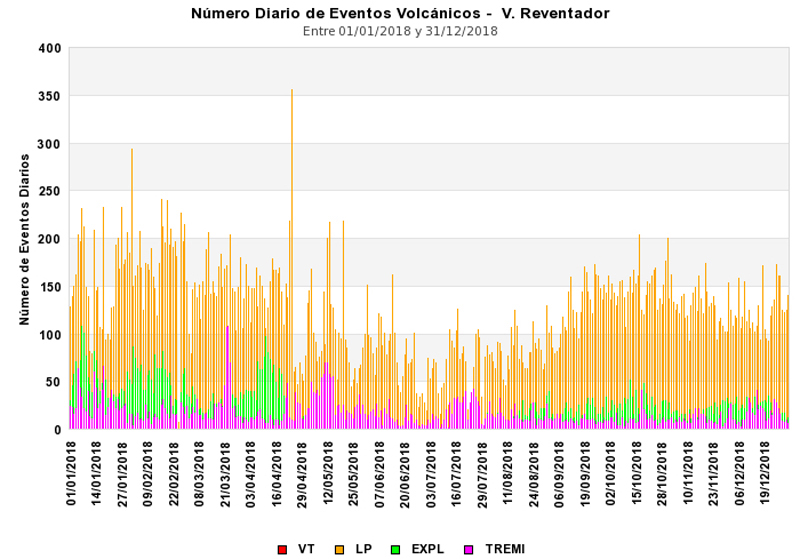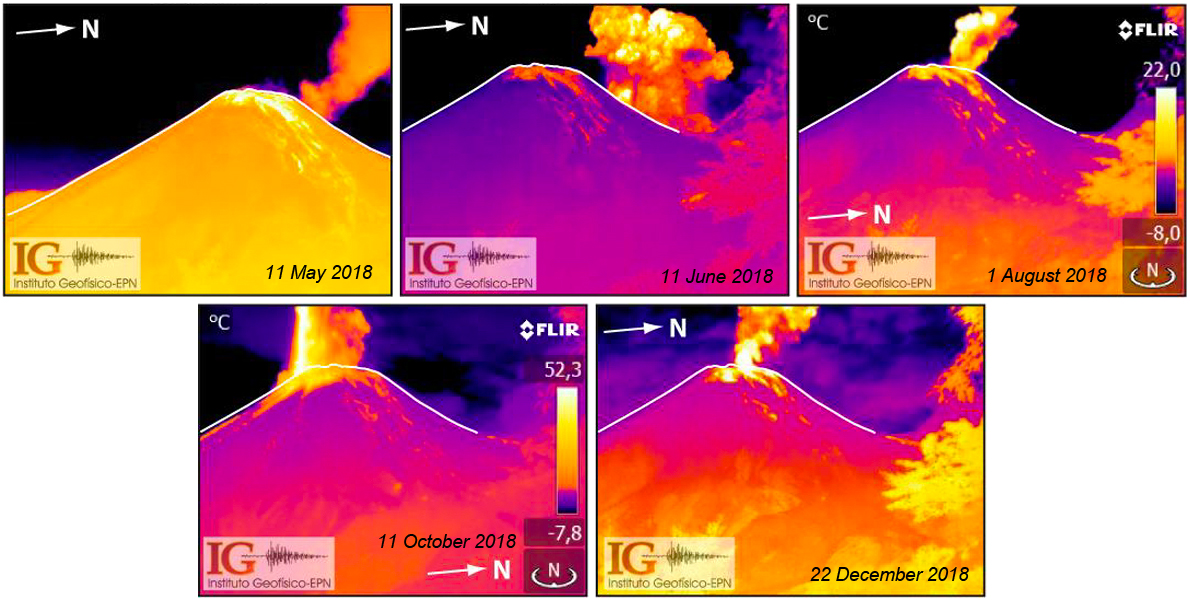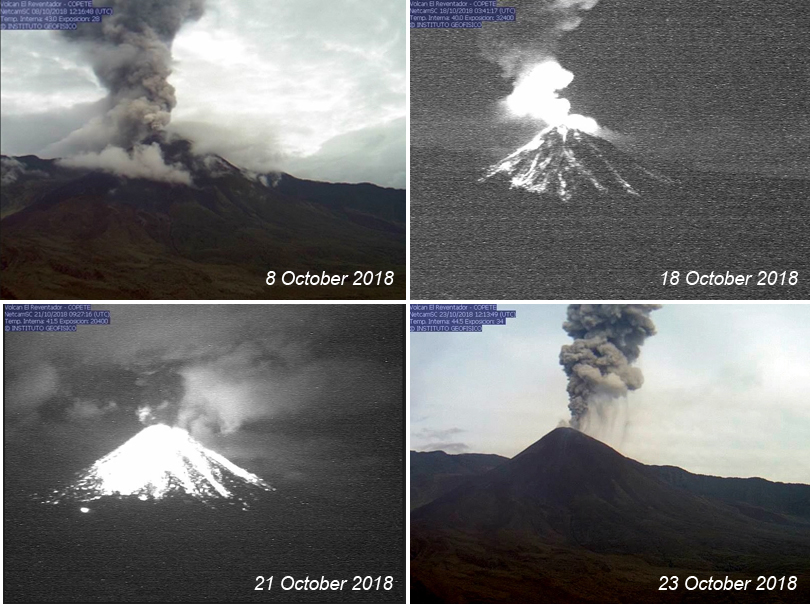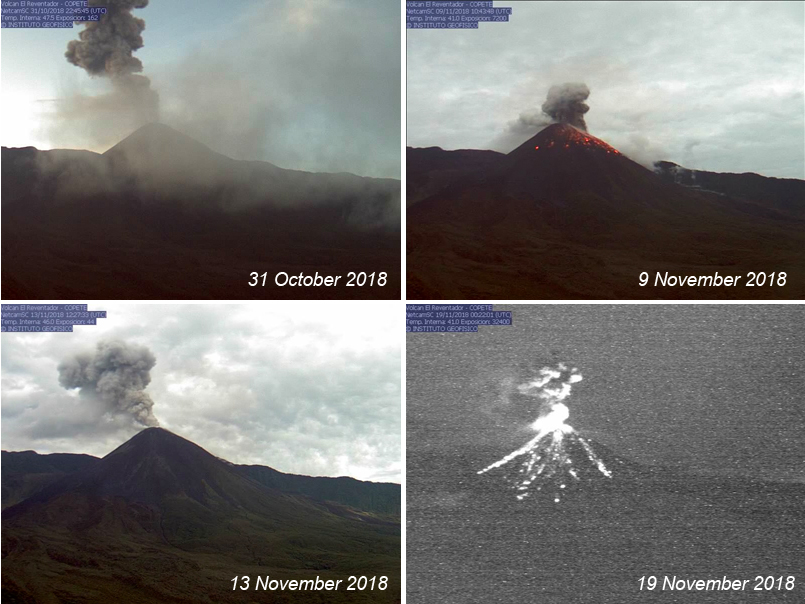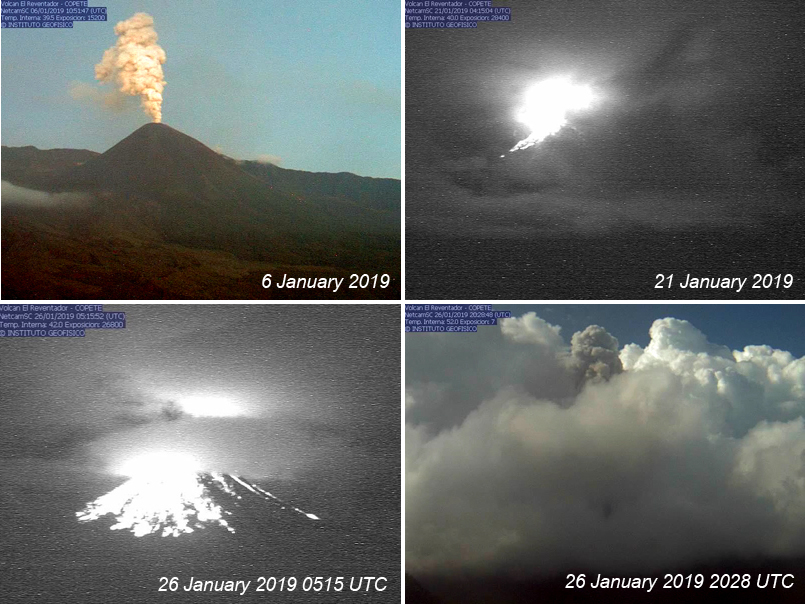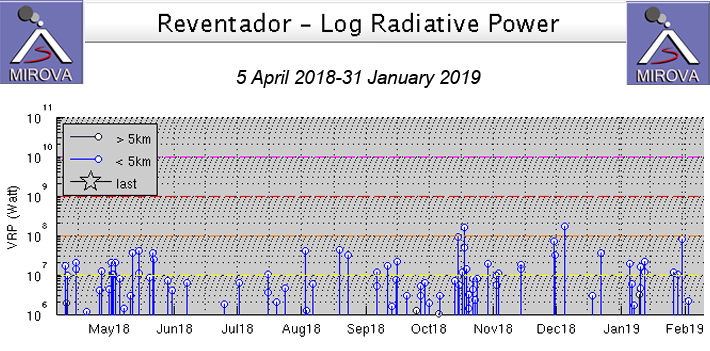Report on Reventador (Ecuador) — March 2019
Bulletin of the Global Volcanism Network, vol. 44, no. 3 (March 2019)
Managing Editor: Edward Venzke.
Edited by A. Elizabeth Crafford.
Reventador (Ecuador) Multiple daily explosions with ash plumes and incandescent blocks rolling down the flanks, October 2018-January 2019
Please cite this report as:
Global Volcanism Program, 2019. Report on Reventador (Ecuador) (Crafford, A.E., and Venzke, E., eds.). Bulletin of the Global Volcanism Network, 44:3. Smithsonian Institution. https://doi.org/10.5479/si.GVP.BGVN201903-352010
Reventador
Ecuador
0.077°S, 77.656°W; summit elev. 3562 m
All times are local (unless otherwise noted)
The andesitic Volcán El Reventador lies well east of the main volcanic axis of the Cordillera Real in Ecuador and has historical eruptions with numerous lava flows and explosive events going back to the 16th century. The eruption in November 2002 generated a 17-km-high eruption cloud, pyroclastic flows that traveled 8 km, and several lava flows. Eruptive activity has been continuous since 2008. Daily explosions with ash emissions and ejecta of incandescent blocks rolling hundreds of meters down the flanks have been typical for many years. Activity continued during October 2018-January 2019, the period covered in this report, with information provided by Ecuador's Instituto Geofisico (IG-EPN), the Washington Volcano Ash Advisory Center (VAAC), and infrared satellite data.
Multiple daily reports were issued from the Washington VAAC throughout the entire October 2018-January 2019 period. Plumes of ash and gas usually rose to altitudes of 4.3-6.1 km and drifted about 20 km in prevailing wind directions before either dissipating or being obscured by meteoric clouds. The average number of daily explosions reported by IG-EPN for the second half of 2018 was more than 20 per day (figure 104). The many explosions during the period originated from multiple vents within a large scarp that formed on the W flank in mid-April (BGVN 43:11, figure 95) (figure 105). Incandescent blocks were observed often in the IG webcams; they traveled 400-1,000 m down the flanks.
Activity during October 2018-January 2019. During most days of October 2018 plumes of gas, steam, and ash rose over 1,000 m above the summit of Reventador, and most commonly drifted W or NW. Incandescence was observed on all nights that were not cloudy; incandescent blocks rolled 400-800 m down the flanks during half of the nights. During episodes of increased activity, ash plumes rose over 1,200 m (8, 10-11, 18-19 October) and incandescent blocks rolled down multiple flanks (figure 106).
Similar activity continued during November. IG reported 17 days of the month with steam, gas, and ash emissions rising more than 1,000 m above the summit. The other days were either cloudy or had emissions rising between 500 and 1,000 m. Incandescent blocks were usually observed on the S or SE flanks, generally travelling 400-600 m down the flanks. The Washington VAAC reported a discrete ash plume at 6.1 km altitude drifting WNW about 35 km from the summit on 15 November. The next day, intermittent puffs were noted moving W, and a bright hotspot at the summit was visible in satellite imagery. During the most intense activity of the month, incandescent blocks traveled 800 m down all the flanks (17-19 November) and ash plumes rose over 1,200 m (23 November) (figure 107).
Steam, gas, and ash plumes rose over 1,200 m above the summit on 1 December. The next day, there were reports of ashfall in San Rafael and Hosteria El Hotelito, where they reported an ash layer about 1 mm thick was deposited on vehicles during the night. Ash emissions exceeded 1,200 m above the summit on 5 and 6 December as well. Incandescent blocks traveled 800 m down all the flanks on 11, 22, 24, and 26 December, and reached 900 m on 21 December. Ash emissions rising 500 to over 1,000 m above the summit were a daily occurrence, and incandescent blocks descended 500 m or more down the flanks most days during the second half of the month (figure 108).
During the first few days of January 2019 the ash and steam plumes did not rise over 800 m, and incandescent blocks were noted 300-500 m down the S flank. An increase in activity on 6 January sent ash-and-gas plumes over 1,000 m, drifting W, and incandescent blocks 1,000 m down many flanks. For multiple days in the middle of the month the volcano was completely obscured by clouds; only occasional observations of plumes of ash and steam were made, incandescence seen at night through the clouds confirmed ongoing activity. The Washington VAAC reported continuous ash emissions moving SE extending more than 100 km on 12 January. A significant explosion late on 20 January sent incandescent blocks 800 m down the S flank; although it was mostly cloudy for much of the second half of January, brief glimpses of ash plumes rising over 1,000 m and incandescent blocks traveling up to 800 m down numerous flanks were made almost daily (figure 109).
Visual evidence from the webcams supports significant thermal activity at Reventador. Atmospheric conditions are often cloudy and thus the thermal signature recorded by satellite instruments is frequently diminished. In spite of this, the MODVOLC thermal alert system recorded seven thermal alerts on three days in October, four alerts on two days in November, six alerts on two days in December and three alerts on three days in January 2019. In addition, the MIROVA system measured moderate levels of radiative power intermittently throughout the period; the most intense anomalies of 2018 were recorded on 15 October and 6 December (figure 110).
Geological Summary. Volcán El Reventador is the most frequently active of a chain of Ecuadorian volcanoes in the Cordillera Real, well east of the principal volcanic axis. The forested, dominantly andesitic stratovolcano has 4-km-wide avalanche scarp open to the E formed by edifice collapse. A young, unvegetated, cone rises from the amphitheater floor to a height comparable to the rim. It has been the source of numerous lava flows as well as explosive eruptions visible from Quito, about 90 km ESE. Frequent lahars in this region of heavy rainfall have left extensive deposits on the scarp slope. The largest recorded eruption took place in 2002, producing a 17-km-high eruption column, pyroclastic flows that traveled up to 8 km, and lava flows from summit and flank vents.
Information Contacts: Instituto Geofísico (IG-EPN), Escuela Politécnica Nacional, Casilla 17-01-2759, Quito, Ecuador (URL: http://www.igepn.edu.ec); Washington Volcanic Ash Advisory Center (VAAC), Satellite Analysis Branch (SAB), NOAA/NESDIS OSPO, NOAA Science Center Room 401, 5200 Auth Rd, Camp Springs, MD 20746, USA (URL: www.ospo.noaa.gov/Products/atmosphere/vaac, archive at: http://www.ssd.noaa.gov/VAAC/archive.html); MIROVA (Middle InfraRed Observation of Volcanic Activity), a collaborative project between the Universities of Turin and Florence (Italy) supported by the Centre for Volcanic Risk of the Italian Civil Protection Department (URL: http://www.mirovaweb.it/); Hawai'i Institute of Geophysics and Planetology (HIGP) - MODVOLC Thermal Alerts System, School of Ocean and Earth Science and Technology (SOEST), Univ. of Hawai'i, 2525 Correa Road, Honolulu, HI 96822, USA (URL: http://modis.higp.hawaii.edu/).


